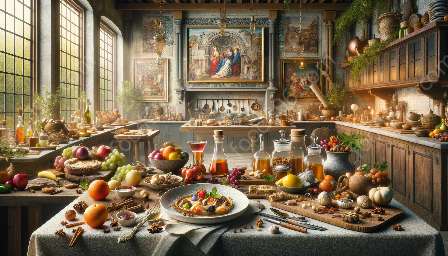The Renaissance era, a time of artistic and intellectual revival, also had a profound impact on the world of cuisine. The cuisine of the Renaissance period played a pivotal role in shaping the modern gastronomy we know today. This topic cluster will explore the historical significance of Renaissance cuisine and its influence on the evolution of cooking techniques, ingredients, and flavors.
Renaissance Cuisine History
The Renaissance, which began in Italy in the 14th century and later spread across Europe, marked a period of great cultural and culinary transformation. Amidst the flourishing arts, literature, and scientific advancements, the world of cuisine also experienced significant changes.
Renaissance cuisine was characterized by a departure from the heavy, spice-laden flavors of the medieval period. Instead, there was a renewed emphasis on natural flavors and the use of local, seasonal ingredients. The cuisine of this era embraced a more refined and delicate approach to cooking, with a focus on aesthetics and presentation.
The royal courts and aristocratic households were centers of culinary innovation during the Renaissance, where talented chefs and cooks experimented with new cooking techniques and flavor combinations. The renewed interest in classical texts on gastronomy, such as Apicius' De re coquinaria, also inspired a revival of ancient Roman and Greek culinary traditions.
Impact on Modern Gastronomy
The legacy of Renaissance cuisine continues to influence modern gastronomy in several significant ways. One of the most impactful contributions is the emphasis on fresh, locally sourced ingredients. Renaissance chefs prioritized the use of seasonal produce and locally available meats and seafood, laying the groundwork for the farm-to-table movement that is celebrated in contemporary culinary culture.
Furthermore, the Renaissance period witnessed a fusion of culinary traditions as a result of trade and exploration. The introduction of new ingredients from the Americas, such as tomatoes, potatoes, and chili peppers, transformed European cooking and expanded the flavor palette of gastronomy. The exchange of culinary knowledge between different cultures during this era paved the way for the global culinary diversity we enjoy today.
Renaissance cuisine also played a pivotal role in elevating the art of presentation and dining experience. The emphasis on aesthetics and elegant table settings during this period contributed to the development of modern culinary aesthetics and the concept of fine dining. The meticulous approach to plating and garnishing, as well as the use of tableware and dining etiquettes, can be traced back to the refined dining practices of the Renaissance era.
Cuisine History
To fully appreciate the impact of Renaissance cuisine on modern gastronomy, it is essential to understand the broader history of cuisine. Cuisine history encompasses the evolution of culinary practices, food traditions, and culinary techniques across different civilizations and historical periods. From the ancient cooking methods of early human societies to the sophisticated culinary arts of modern times, cuisine history provides valuable insights into the cultural, social, and technological influences on food and dining.
The history of cuisine reflects the dynamic interaction between the environment, agriculture, trade, and cultural exchange. It is a narrative of creativity, innovation, and adaptation as people across the globe have continuously shaped and reshaped their culinary traditions in response to changing circumstances and influences.
By examining the historical trajectory of cuisine, we gain a deeper understanding of the diverse origins of ingredients, cuisines, and cooking techniques. This knowledge enables us to appreciate the rich tapestry of flavors and culinary practices that have evolved over centuries, laying the foundation for the vibrant mosaic of global gastronomy we savor today.

